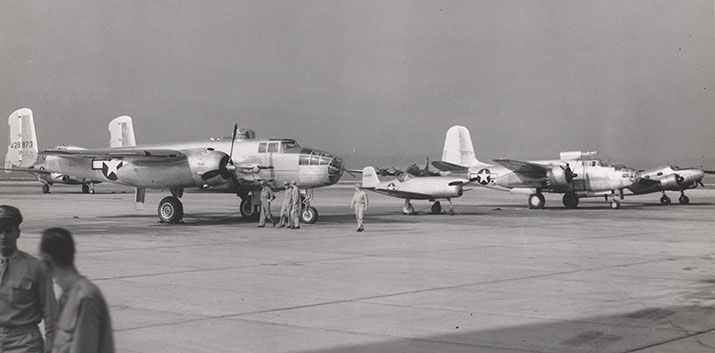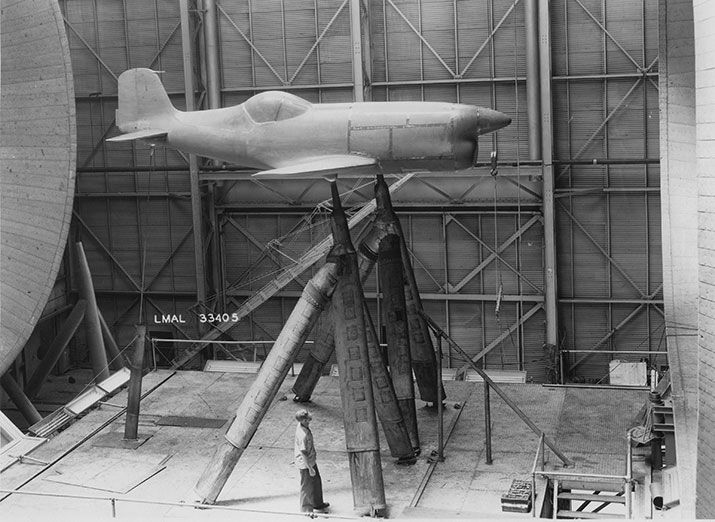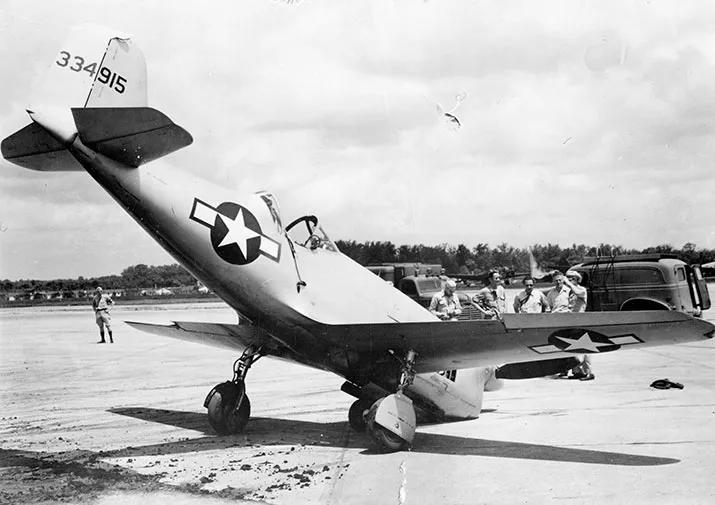Larry Bell’s little idea probably should have been kept to himself.
The Bell XP-77.
/https://tf-cmsv2-smithsonianmag-media.s3.amazonaws.com/filer/Cancelled-Larry-Bell-Little-Idea-631.jpg)
Bell Aircraft’s chief engineer, Robert Woods, was a whiz at coming up with boundary-busting ideas (he led the team that built the X-1), but when it came to turning his proposals into products, he was less adept. There’s no better example than his concept for an interceptor, the Bell XP-77. Looking like something a 14-year-old might sketch in study hall, it was to be a single-seater as lightweight as a Cessna 172, made entirely of wood—a “non-strategic” material at a time of war-related aluminum-alloy shortages—and powered by a small Ranger (a division of Fairchild) V-12 engine, the 520-horsepower XV-770.
The XP-77 was to have just one job—point defense: protect a single installation, like a base or command center from the bombers coming to attack it. The job required a rapid climb to high altitude, where the interceptor would shoot down bombers from behind. The -77 carried a mere 56 gallons of fuel and barely enough guns and cannon to damage a heavy bomber. It also displayed little talent as a fighter, the assumption being that the bombers would be unescorted. It didn’t help that Bell knew nothing about building wooden airplanes; worse was a series of assumptions about how lightweight the company could make the interceptor.
To this day, air forces complain that fighters are getting too complex, too big, and too heavy, and that what’s needed is “a lightweight fighter.” So it was in the early 1940s, when fighters had grown from the 3,000-pound Boeing P-26 Peashooter of the mid-1930s to the 17,500-pound Lockheed P-38 and Republic P-47. Airplanes with bigger guns needed more powerful engines, and those needed more fuel, so airframes grew in size and weight and needed even more powerful engines. Woods wanted to rewrite the script that created such monsters.
In 1935, only weeks after Larry Bell founded the Bell Aircraft Corporation, he suggested to his new chief engineer that they build a lightweight wooden airplane and enter it in the Cleveland National Air Races to garner publicity. Bob Woods didn’t know much about air racing, but he quickly sketched a slick Thompson Trophy racer concept—which never did race. The XP-77’s small cockpit was so far aft that the pilot could plainly see the main gear under the wings when it was extended; the airplane had an up/down indicator light only for the nosegear. On the plus side, the tricycle gear enabled stable ground handling.
The wings were small and thin, with a delicate laminar-flow airfoil, and had no room for fuel tanks; the XP-77 carried its gas in a single fuselage tank in front of the cockpit. Ranger had promised to build a supercharged version of the V-770 that supposedly would have driven the interceptor to 410 mph at 27,000 feet, but the supercharger never materialized.
What the U.S. Army Air Forces needed was not single-purpose aircraft—pursuits, interceptors, bomber destroyers, parasite fighters, and point defenders. It needed multi-mission aircraft: long-range, well-equipped, six- and eight-gun bruisers that could escort, strafe, and bomb, as well as dogfight—what eventually came to be called air-superiority fighters. Troublemakers like the P-38, P-47, and P-51.
Ultimately, the Army Air Forces estimated that a production P-77 would have a loaded weight of 3,750 pounds and concluded that such an airplane “would have no appreciable advantage in speed, climb, maneuverability or firepower over the current production [fighters].” The only way to make the XP-77 competitive would have been to reduce the gross weight to 3,000 pounds, which would mean either throwing out 75 percent of the useful load—fuel, guns, cannon, and ammunition, to say nothing of the pilot—or completely re-engineering the airframe. But it was too late for that: Two XP-77s had been built, and that was all the government was willing to pay for.
You can see the surviving aircraft at the National Museum of the U.S. Air Force in Dayton, Ohio. The second prototype was destroyed in a crash at Florida’s Eglin Field in October 1944. The pilot bailed out when the airplane entered an inverted spin.
Stephan Wilkinson has a liking for little wooden airplanes, having built one himself, a Falco F8L. Unlike the XP-77, his flew just fine.


